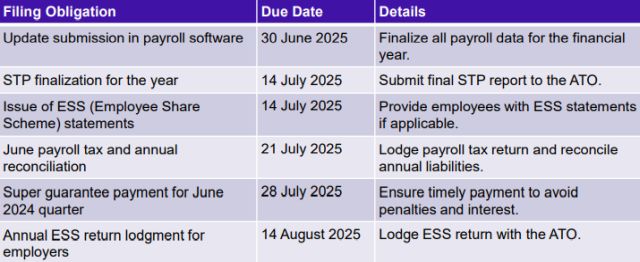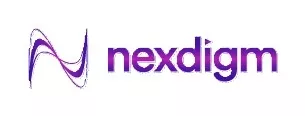- within Employment and HR topic(s)
- in Australia
- within Employment and HR, International Law, Government and Public Sector topic(s)
As of 30 June 2024, there were 2.66 million actively trading businesses in Australia—nearly 1 million of them employing staff. The close of the 2024– 2025 financial year marks a critical window to ensure full compliance with payroll obligations under the Australian Taxation Office (ATO).
From updated employee data and superannuation contributions to Single Touch Payroll (STP) Phase 2 finalizations and Fringe Benefits Tax (FBT) declarations, the compliance landscape is increasingly structured—and unforgiving.
For global companies with Australian branches, overlooking payroll year-end obligations can lead to regulatory penalties, misreporting under STP, and disruptions in employee tax processing issues that directly impact operational continuity and employee trust. With final submissions due by 14 July 2025, employers must act now.
To ensure a thorough and compliant payroll year-end process, employers should carefully follow these key steps:
Review and Update Employee Details
At the end of the financial year, one of the most crucial payroll tasks is verifying that all employee records are accurate and complete in your payroll system. This includes ensuring the correctness of full legal names, Tax File Numbers (TFNs), residential addresses, superannuation fund details, and employment status—including termination dates for employees who have left during the year.
Best Practice
Employers should cross-check employee information against on boarding documents and ATO records to ensure consistency and compliance.
Why It Matters
Inaccurate or outdated employee data can result in rejected STP submissions, misreporting to the ATO, and delays in employee tax processing.
Common Errors to Avoid
- Misspelled names or incorrect TFNs that cause STP submission failures.
- Outdated addresses that disrupt superannuation fund communications.
- Missing termination dates, which can lead to incorrect reporting of employment status.
Reconcile Payroll Records
Employers should cross-check payroll reports with financial records to ensure all wages, taxes, and super contributions are correctly recorded.
- Finalize the last payroll run for the year.
- Generate payroll summary, general ledger, and superannuation reports.
- Cross-check totals with accounting records and STP submissions.
- Correct any discrepancies.
Best Practice
Use payroll software with built-in reconciliation tools.
Why it matters
Reconciliation helps detect discrepancies early and ensures accurate year-end reporting. It ensures your payroll data aligns with financial records and ATO submissions.
Common Errors
- Overlooking bonus payments or leave loading in final payroll.
- Mismatched PAYG withholding between payroll and BAS reports.
- Super contributions not reflecting salary sacrifice arrangements.
FBT and Superannuation Reporting
As part of year-end payroll compliance, employers must accurately report fringe benefits and superannuation contributions in line with STP Phase 2 requirements. This includes identifying any fringe benefits provided to employees and ensuring super contributions are correctly classified.
FBT
If an employee has received fringe benefits with a taxable value exceeding AUD 2,000, the grossed-up value must be reported through STP. This ensures transparency and proper taxation of non-cash benefits.
Superannuation Contributions
Employers must also ensure the correct configuration of Reportable Employer Superannuation Contributions (RESC):
- Salary Sacrifice Super Contributions should be marked as 'Salary Sacrifice S' in the payroll system.
- Additional Employer Contributions influenced by the employee (e.g., negotiated as part of a salary package) must be flagged as RESC using the appropriate settings.
Why it matters
Misreporting fringe benefits or super contributions can result in compliance breaches, penalties, and inaccurate employee income statements. Proper classification is essential for both employer obligations and employee tax reporting.
Common Errors to Avoid
- Failing to report FBT amounts via STP, especially when thresholds are exceeded.
- Incorrectly classifying employer super contributions, leading to underreporting of RESC.
- Not updating payroll software to accommodate STP Phase 2 reporting requirements.
Validate Payment Summaries (if applicable)
Although most Australian employers now report employee earnings through STP, some businesses may still need to issue payment summaries—particularly for closely held payees or in cases of amended prior-year data. If your business falls into this category, it's essential to ensure that these summaries are accurate and consistent with your payroll records.
Key Steps to Follow
Verify that both company and employee information is accurate and up to date.
Cross-check payment summaries against payroll reports to ensure consistency in gross earnings and tax withheld.
Why It Matters
Errors in payment summaries can lead to confusion for employees and result in incorrect tax filings. Issuing summaries when STP finalization has already been completed can also cause duplication and reporting conflicts.
Common Errors to Avoid
- Issuing payment summaries with incorrect gross income or PAYG withholding amounts.
- Providing summaries to employees after STP finalization has already been submitted, leading to confusion and potential double reporting.
STP Finalization and Submission
The finalization of STP data is one of the most critical compliance steps in the year-end payroll process. Employers must ensure that all payroll information submitted to the ATO is complete, accurate, and reflects the full financial year's earnings for each employee.
Why it matters
The STP finalization is the official record of employee earnings for the financial year. Missing the deadline or submitting incorrect data can result in penalties and delays in employee tax return processing.
Common Errors to Avoid
- Missing the 30 June deadline, which prevents any further updates for the prior financial year.
- Submitting incorrect totals due to unresolved payroll discrepancies.
- Failing to notify employees that their income statements are ready for tax return lodgment in myGov.
Key Year-End Payroll Deadlines for 2024–2025

Final Thoughts
Year-end payroll is a vital compliance activity that requires attention to detail, timely action, and a clear understanding of reporting obligations. By avoiding common errors and following best practices, employers can ensure a smooth close to the financial year and maintain compliance with ATO requirements.
The content of this article is intended to provide a general guide to the subject matter. Specialist advice should be sought about your specific circumstances.
[View Source]

